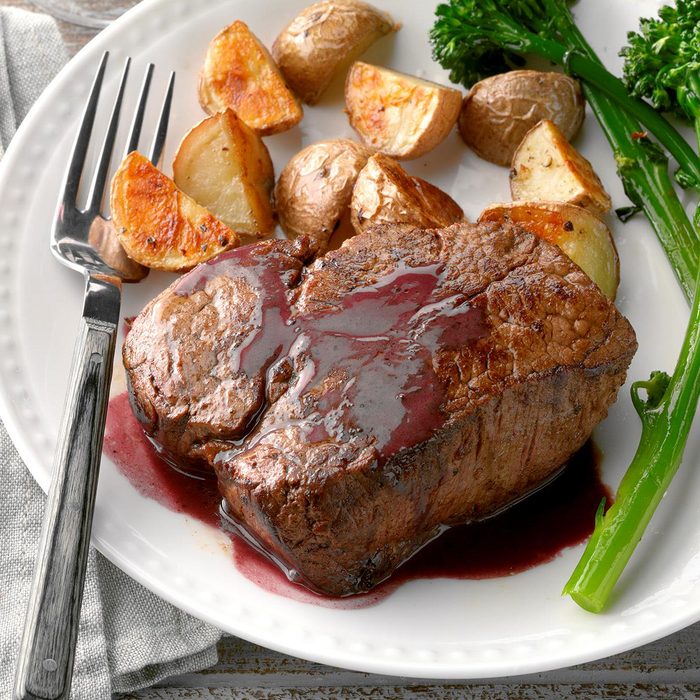Living with diabetes can limit some of your food options, but that doesnt mean you have to cut things out completely. Learn about the health impacts of meat on diabetes in our guide to diabetic-friendly meats.
For people with diabetes, it’s important to make smart decisions when selecting proteins. Not surprisingly, some choices are better for your health than others! Be cautious of anything that’s breaded, as it will impact your blood sugar levels and can make it hard to quantify the carbs you’re consuming. Keep an eye on the amount of saturated fat in meat, too, because heart disease is a common comorbidity of diabetes. (To find saturated fat, look for visible white fat in the meat as well as skin on the meat.)
Finally, avoid processed meats. Items like deli meats and sausage can contain compounds and additives that are inflammatory agents, exacerbating diabetes and leading to other chronic illnesses in the future.
What meats are good for type 2 diabetes? Look for lean meats with little visible fat, skinless cuts and meats in their most natural form—whole cuts of meat as opposed to processed options. Find more about how type 2 diabetes affects your diet.
A diet high in red meat has been shown to contribute to many chronic illnesses, including diabetes. However, certain cuts of red meat can be worse than others for those with diabetes. Marbling refers to the white fat that can be seen throughout a cut of meat, which is primarily composed of saturated fat. Saturated fat has been shown to increase inflammation and even promote insulin resistance.
Is steak OK for diabetics? If you’re choosing cuts of meat with less marbling, steak can certainly fit into a diabetes-friendly diet in moderation.
Some fish can be incredible protein options for those with diabetes. However, fried fish is not recommended. It can be high in calories, which can lead to weight gain, making diabetes much harder to control. The carbohydrates from the batter can also be hard to quantify, throwing off your carb count for the day.
Deli meats are typically full of sodium and additives, including nitrates. Nitrates have been found to possibly interfere with normal insulin production and could promote insulin resistance in the body.
What kind of lunch meat can diabetics eat? There are lunch meat options available with minimal additives and lower sodium content. Ask to see labels of the different options next time you’re at the deli counter.
Does meat raise blood sugar? Not unless there is a carb eaten alongside it. But saturated fat and additives can impact your overall health, affecting your body’s ability to manage its blood sugar levels.
Processed meat, like bacon, has also been deemed a Group 1 carcinogenic food by the World Health Organization. It triggers an inflammatory response in the body when eaten, contributing to diabetes.
Can a Diabetic Eat Turkey? A Nutritious Protein Option for Managing Blood Sugar
Turkey can be a healthy and delicious protein choice for people with diabetes. With proper portion control and cooking methods, it provides key nutrients while keeping carbohydrates and fat intake low This makes turkey an excellent addition to a diabetic-friendly meal plan
What Makes Turkey a Good Option for Diabetics?
Turkey is packed with protein and relatively low in fat, especially when skinless cuts are chosen. The ample protein promotes satiety while having minimal effect on blood sugar levels. The low glycemic index of turkey prevents sharp spikes in glucose. Its nutritional profile gives turkey the edge over proteins like red meat and processed deli meats.
Here are some key benefits that make turkey suitable for diabetics:
-
Lean source of protein: A 3-4 oz portion of skinless turkey breast provides about 25 grams of protein with negligible carbs that impact blood sugar. The protein contributes to fullness and stable energy levels.
-
Low in fat and calories: Skinless white turkey meat is significantly lower in saturated fat and calories compared to marbled cuts of beef and high-fat processed meats like bacon. This helps manage weight and cardiovascular health.
-
Rich in nutrients: Turkey provides antioxidants like selenium along with B vitamins including niacin. It’s a source of zinc and phosphorus as well.
-
Versatile ingredient: Turkey breast can be incorporated into various dishes like sandwiches, salads, soups, and wraps, adding nutrition without spiking blood sugar.
-
Lower glycemic index: With a GI of about 55, turkey has less impact on blood glucose than high GI foods like potatoes. This helps maintain steady blood sugar.
How Does Turkey Compare to Other Protein Sources?
-
Poultry: Skinless chicken breast is comparable to turkey as a lean protein low in saturated fat. But turkey tends to edge out chicken slightly in terms of lower overall fat content.
-
Red meat: Beef contains more saturated fat and calories than white turkey meat. Leaner cuts like sirloin can be occasionally enjoyed in moderation.
-
Processed meats: Deli meats like ham and bacon contain added sodium, nitrates, and higher fat so should be restricted.
-
Seafood: Fish like salmon provide heart-healthy fats. But turkey has an advantage when carb counting given the zero carbs in it.
-
Plant proteins: Beans and tofu contain fiber, making them excellent choices. Turkey provides more protein per serving than most plant proteins.
What is the Best Way to Cook Turkey for Diabetics?
Choosing the right cooking method is key to retaining the health benefits of turkey:
-
Roasting: Cooks the turkey evenly without adding extra fat.
-
Baking: Also promotes even cooking and avoids excess oil or butter.
-
Grilling: Imparts flavor from the grill while using little added fat.
-
Boiling/Poaching: Keeps turkey moist and tender without oils.
-
Steaming: Retains moisture and cooks gently.
High temperature cooking methods like deep frying and pan frying in oil should be limited as they add significant calories and fat.
What is a Healthy Portion Size of Turkey for Diabetics?
Portion control is essential for diabetics when incorporating turkey into meals:
-
Ideal serving: 3-4 ounces, about the size of a deck of cards
-
Provides: 25+ grams of protein
-
Helps: Keep calories in check and prevent overeating
-
Caution: Consuming too much, especially deli turkey, can increase sodium intake
Sticking to proper portions ensures that turkey remains a diabetes-friendly choice that contributes to stable blood sugar rather than weight gain or other health risks.
How Can Diabetics Include Turkey in a Balanced Meal Plan?
When planning meals, diabetics can include turkey as:
-
A salad topper: Slice turkey breast to top a salad full of non-starchy vegetables.
-
A sandwich or wrap filling: Combine sliced turkey with veggies in a whole grain wrap.
-
An omelet or breakfast scramble ingredient: Dice turkey to add protein to egg dishes.
-
An addition to soups: Throw turkey chunks or ground turkey into vegetable-packed soups.
-
A pizza topper: Use turkey pepperoni or turkey sausage crumbles instead of pork varieties.
Pairing turkey with non-starchy vegetables, whole grains, beans, and healthy fats results in a balanced plate that keeps blood sugar stable.
What Health Benefits Does Turkey Offer for Diabetics?
Consumed in moderation, turkey provides important health perks:
-
Aids weight management: Turkey’s low fat and calorie count support a healthy weight, which helps control diabetes.
-
Improves heart health: The reduced saturated fat intake compared to red meat cuts cardiovascular risk.
-
Provides vital nutrients: Selenium, niacin, and vitamin B6 in turkey support overall health.
-
Decreases inflammation: The nutrients in turkey help lower inflammation linked to diabetes.
-
Protects nerve health: Thiamine and other B vitamins help prevent diabetes-related nerve damage.
These benefits make turkey a smart component of an overall healthy lifestyle for diabetics.
What Are Some Alternatives to Turkey for Diabetics?
For those looking to vary protein choices beyond turkey, some healthy options include:
-
Skinless chicken and other poultry: Opt for white meat and remove skin to reduce fat.
-
Fatty fish: Salmon, mackerel, sardines are excellent choices with anti-inflammatory fats.
-
Plant proteins: Beans, lentils, tofu, and tempeh are high fiber options with zero carbs.
-
Eggs: Provide protein, vitamins, and antioxidants; limit to one whole egg per day.
-
Low-fat dairy: Greek yogurt and cottage cheese offer calcium and protein without excess saturated fat.
Varying proteins while keeping portions in check ensures a balanced diabetic diet.
Can Diabetics Enjoy Turkey During the Holidays?
Turkey can be part of holiday meals with some adjustments:
-
Select white meat without skin to limit fat intake
-
Substitute starchy sides with non-starchy vegetables
-
Avoid sugary glazes; use herbs and spices to flavor
-
Portion turkey alongside fiber-rich foods to prevent blood sugar spikes
-
Balance sweets out with proteins and healthy fats
With mindful meal composition, diabetics can still enjoy festive turkey. Moderating carbs and saturated fat intake allows for inclusion of turkey in healthy holiday eating.
The American Diabetes Association endorses turkey as a lean protein source that aligns with dietary recommendations for managing diabetes. Keeping tabs on portion sizes, cooking methods, and meal composition allows diabetics to benefit from turkey’s stellar nutritional profile. While delicious alternatives certainly exist, turkey remains an adaptable protein option with the ability to keep blood sugar levels stable. With some savvy meal planning, turkey can be incorporated into diabetes-friendly eating patterns throughout the year.

Worst: Grilled Skin-On Poultry
The skin found on poultry like chicken is loaded with saturated fat. Research has also found that high-heat cooking methods like grilling actually increase diabetes risk and can make management more difficult for those who already have the disease. This is most likely related to the by-products created during high-heat cooking.
Nutrition Facts
4 ounces: 209 calories, 21g protein, 14g fat (4g saturated fat), 0g carbohydrate, 71g sodium

Best: Skinless Chicken Breast
When the skin is removed, chicken is actually a great protein choice for those with diabetes! Breast meat is the first cut to choose as it has the lowest amount of fat throughout the meat. Use skinless chicken breast in one of these easy recipes for people with diabetes alongside some of the best vegetables for diabetics.
Nutrition Facts
4 ounces: 93 calories, 20g protein, 1g fat (0g saturated fat), 0g carbohydrate, 55g sodium
Salmon and other fatty fish like anchovies and sardines are smart choices for those with diabetes. These fish are full of omega-3 saturated fatty acids, which have been found to have a protective effect against type 2 diabetes. Pair salmon with one of these diabetic “free foods” for a delicious, balanced meal.
Nutrition Facts
3 ounces: 177 calories, 17g protein, 11g fat(3g saturated fat), 0g carbohydrate, 50g sodium

Pork tenderloin is a protein choice that you can embrace. It’s a super lean cut of meat that’s very low in saturated fat and can be used in dozens of delicious recipes paired with some of the best foods for diabetics. Try our Parmesan Pork Medallions or Easy Slow-Cooked Pork Tenderloin!
Can diabetics eat pork? While bacon is one protein to steer clear of, this doesn’t mean you can’t enjoy other cuts of pork. (Learn when it’s safe to eat pink pork.)
Nutrition Facts
3 ounces: 122 calories, 22g protein, 3g fat (1g saturated fat), 0g carbohydrate, 48g sodium

While excessive amounts of red meat in your diet will make diabetes harder to control, enjoying it every once in a while shouldn’t cause harm. When you are having red meat, it’s important to choose a lean cut. Filet mignon with no visible fat is a great example. You might be surprised by some of our other diabetic-friendly dinner ideas, too.
Nutrition Facts
3 ounces: 227 calories, 22g protein, 15g fat (6g saturated fat), 0g carbohydrate, 46g sodium

Eggs (both the white and yolk) are a phenomenal protein choice for those with diabetes. Recent evidence shows there’s no need to be concerned with the cholesterol they contain, as it won’t negatively impact your blood cholesterol. Eggs are also full of vitamin D, which has been found to increase the body’s sensitivity to insulin, helping you to better control your blood sugar. Check out these brunch recipes for people with diabetes.
Nutrition Facts
2 large eggs: 156 calories, 12g protein, 10g fat (3 g saturated fat), 0g carbohydrate, 124g sodium

5 BEST MEATS FOR DIABETICS (TO LOWER BLOOD SUGAR)
FAQ
Does turkey raise blood sugar?
What is the best turkey for diabetics?
Is deli turkey OK for diabetics?
